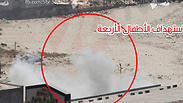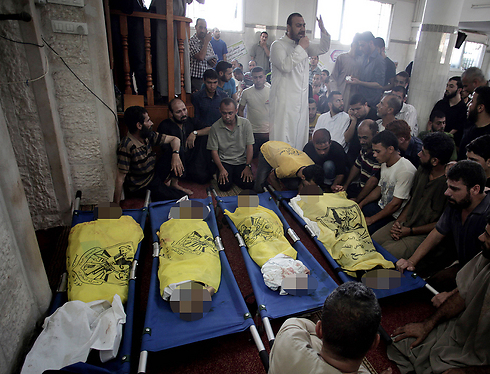
Footage from the strike

Report: Israel noted mistakes that led to death of 4 Gazan kids in 2014 airstrike
The Intercept website claims to have seen a report produced by the IDF military police that concluded that the strike on a Gaza beach that caused an international outcry was due to an Israeli drone mistaking the kids for Hamas terrorists, and a failure by the operator to await further instructions after the death of the first boy.
A 2015 report carried out by the Military Investigative Police identified a string of mistakes made by the Israel Air Force, the Israel Navy and the IDF’s intelligence branch prior to an attack that led to the killing of four Palestinian children in an airstrike launched on a Gaza beach during Operation Protective Edge in 2014.
According to an article published at the beginning of the week on the American website “The Intercept”, Israel compiled a secret report that concluded that the boys' deaths were caused by missiles launched from an armed drone.
In 2015, the military criminal investigation division (CID) announced that the case had been closed into the suspected criminal case which caused an international outcry after images surfaced showing the boys running before being killed.
Testimony by officers involved in the attack confirmed for the first time that the children—four cousins aged 10-11—were pursued and killed by the drone’s operators, who mistook them for Hamas terrorists.
The Intercept alleges that the impact of the attack could have been mitigated and that the deaths of all four boys could have been prevented.
“After killing the first boy, the drone operators told investigators, they had sought clarification from their superiors as to how far along the beach, used by civilians, they could pursue the fleeing survivors,” The Intercept report says. “Less than a minute later, as the boys ran for their lives, the drone operators decided to launch a second missile, killing three more children, despite never getting an answer to their question.”
The Intercept claims to have seen the military report which documents how on the day of the strike, an Israeli Hermes 450 surveillance drone hovering over a beach in Gaza City transmitted images of eight figures clambering from the strand onto a jetty.
A small shipping container on the jetty had been already been obliterated by an Israeli missile the previous day, it says, based on intelligence indicating that Hamas naval commandos may have been using it to store weapons.
“Some analysts have questioned that intelligence, however, since there were no secondary explosions after the structure was hit and journalists staying in nearby hotels reported that no militants had been seen around the jetty that week,” The Intercept says.
It goes on to say that the Israeli investigation report concludes that “after one of the figures on the jetty entered the container that had been destroyed the previous day, an Israeli air force commander at the Palmachim air base, south of Tel Aviv, ordered the operators of a second drone, which was armed, to fire a missile at the container.”
The July 16 strike was all the more ignominious for Israel since shortly before it took place the IDF published a video using live feeds from drones to show that the IAF takes efforts to avoid killing non-combatants.
However, Israel acknowledges that civilian deaths are at times unavoidable while fighting in such a densely populated area and has long held that it issues warning to civilians to vacate areas that are marked for an impending strike. It says that Hamas deliberately hides among civilians and hides its military weapons in hospitals and schools in order to goad Israel into attacking and inflicting as many civilians casualties in possible in order to ratchet up international pressure on the country.
The video released by the IDF showed a number of strikes being aborted after civilians were identified in an area about the be hit.
However, the strike that killed the four children—Ismail Bakr, 10; Ahed Bakr, 10; Zakaria Bakr, 10; and Mohammed Bakr, 11—was considered “a great success” at the time according to one of the naval officers, the report says, because they mistakenly believed that it had claimed the lives of four Hamas terrorists readying to carry out a strike on Israel.
IDF video of aborted missions in Gaza (צילום: דובר צה"ל)
After images surfaced in the international media of the strike, the IDF analysed the aerial mission and subsequently recommended that the military police launch and investigation into possible criminal negligence.
The report goes on to allege that the testimonies collected were included in a report presented to Israel’s military advocate general, Maj. Gen. Danny Efroni 11 months later.
“Efroni did not release the testimonies, but did make a summary of the report’s findings public on June 11, 2015, when he closed the investigation without filing any charges. Israel’s chief military prosecutor decided that no further criminal or disciplinary measures would be taken, since the investigators had concluded that ‘it would not have been possible for the operational entities involved to have identified these figures, via aerial surveillance, as children,’” The Intercept says.
The IDF said in a statement that “the incident was thoroughly and comprehensively checked by the General Staff apparatus and investigated by the CID. The investigated that was conducted revealed that the strike that was carried out by the IDF on July 16, 2014 was aimed at figures who were believed to be Hamas activists, who were in a military compound belonging to the naval force of the terror organization, Hamas.
“In hindsight, it turned out that that they were children who entered the compound. The investigation also revealed that the strike was carried out in accordance with acceptable procedures, while taking various precautionary measures that were intended to avoid harming civilians, and that an error of identification was found, which was reasonable in the circumstances of the case,” the statement said.
“Accordingly, in 2015 the investigation was closed without any legal steps. The then Judge Advocate General's decision was published and can be examined,” the statement concluded.

















